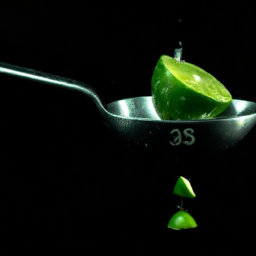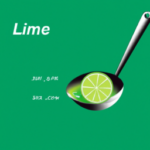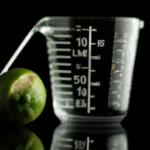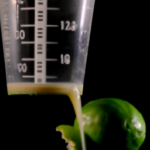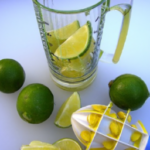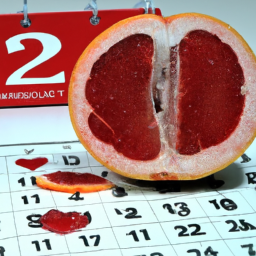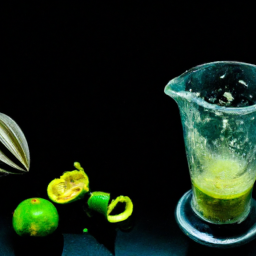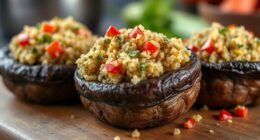I love incorporating limes into my culinary creations. They add a zesty, tangy flavor to a variety of dishes, from guacamole to key lime pie.
But have you ever wondered how much juice is actually in one lime? It can be frustrating to need a certain amount of lime juice for a recipe and not know whether you need one or two limes to get it.
In this article, I will explore the factors that affect the amount of juice in a lime, how to measure lime juice, and tips for getting the most juice out of a lime.
Limes are a popular ingredient in both savory and sweet dishes, as well as in cocktails and other beverages. They are a staple in many cuisines, including Mexican, Thai, and Indian. But the amount of juice you can get from a lime can vary depending on several factors, such as the ripeness of the fruit, the size of the lime, and the juicing method used.
Knowing how to measure and maximize the juice from a lime can make a big difference in the flavor of your dishes and drinks.
Key Takeaways
- A fully ripe lime yields more juice than an unripe one.
- Rolling or microwaving the lime can help extract more juice.
- Using a citrus juicer or alternative tools can also help extract more juice.
- One lime typically yields about 2 tablespoons of juice.
The popularity of limes in cooking and beverages
You can’t deny the mouthwatering tang that limes bring to any dish or drink, making them a staple in the culinary world. Lime cultivation has been around for centuries, and it’s no wonder why these small, green fruits have become so popular.
There are many varieties of limes, each with their own unique flavor and level of acidity. From the Persian lime, which is the most commonly found in grocery stores, to the Key lime, which is smaller and sweeter, limes are a versatile fruit that can be used in a variety of dishes and drinks.
Limes are used in everything from cocktails and marinades to desserts and savory dishes. Their popularity in cooking and beverages is due to their ability to enhance flavors and add a refreshing zing to any dish.
But how much juice is in one lime? That depends on a variety of factors, including the size and ripeness of the lime, as well as the method used to extract the juice.
Factors that affect the amount of juice in a lime
When squeezing a lime, there are a few factors that can influence the amount of juice you can extract. One of the most important factors is lime ripeness. A fully ripe lime will yield more juice than a less ripe one. The reason for this is that as the lime ripens, the cells in the fruit break down and release more juice. Therefore, it’s best to choose limes that are fully ripe and have a little give when you squeeze them.
Another factor that can impact the amount of juice you can extract from a lime is its temperature. When limes are cold, their juice is less likely to flow freely. Conversely, if you warm up the lime, the juice will become more fluid and easier to extract. To get the most juice out of your limes, you can try rolling them on the counter to break down the cell walls before squeezing or microwaving them for 10-15 seconds to warm them up.
Remember, the more juice you can extract, the more flavor you’ll get in your dish or drink. Now that we understand what affects the yield of lime juice, let’s explore how to measure it accurately.
How to measure lime juice
Get ready to savor the tangy flavor of lime by learning how to accurately measure its zesty goodness. Measuring accuracy is crucial when working with lime juice since recipes often call for specific amounts.
A handy tool to use is a citrus juicer, which extracts the maximum amount of juice from the fruit. Simply cut the lime in half and press it onto the juicer. The juice will flow into a container, and you can easily measure the desired amount.
If you don’t have a juicer, there are alternative tools you can use. A fork or a citrus reamer can help you extract the juice, but be careful not to let any seeds fall into the juice. You can also use a hand-held lemon squeezer, which works well for limes too.
To measure the juice, pour it into a measuring cup, or use a tablespoon or teaspoon. Remember to stir the juice before measuring to ensure an even distribution of pulp.
Now that you know how to measure lime juice accurately, let’s move on to tips for getting the most juice out of a lime.
Tips for getting the most juice out of a lime
When it comes to getting the most juice out of a lime, I’ve found that there are a few tricks that can make all the difference.
Firstly, rolling the lime back and forth on a hard surface before squeezing can help to break down the fibers and release more juice.
Secondly, popping the lime in the microwave for just a few seconds can help to warm it up and make it easier to extract the juice.
Finally, cutting the lime in half lengthwise, rather than widthwise, can give you better access to the juice sacs and help you get more out of each piece.
Roll the lime before squeezing
Rolling a lime before squeezing it can help to release more juice, giving your dish a burst of flavor. The benefits of rolling a lime are numerous and can be achieved with any tool for squeezing. Here are a few reasons why rolling is a crucial step:
- The rolling action helps to break down the fibers inside the lime, allowing the juice to flow more freely.
- Applying pressure to the lime while rolling it can also help to loosen the juice, making it easier to extract.
- Rolling a lime can help to get rid of any air pockets that may be trapped inside, which can prevent the juice from coming out.
- The juice released from a rolled lime is often more flavorful, as it contains more of the essential oils found in the lime’s skin.
- Rolling a lime is a quick and easy way to get more juice out of it, without the need for any special equipment.
To maximize the amount of juice you can get out of your lime, consider rolling it before cutting or squeezing.
Another simple trick to getting more juice out of a lime is to microwave it briefly, which we’ll cover in the next section.
Microwave the lime briefly
Microwaving your lime for a short time can be an excellent alternative method to extract its juicy goodness. This technique is perfect for those times when you don’t have a lot of limes or when you need to get the most out of your fruit.
Microwaving the lime briefly can help break down the cell walls in the lime, making it easier to extract its juice. Additionally, microwaving can enhance the taste of your lime, making it more flavorful than when you squeeze it without heating it. The benefits of microwaving your lime go beyond just making it easier to extract its juice.
When you heat up the lime, the heat can also kill off any bacteria that may be present on the outside of the fruit. This can help reduce the risk of any foodborne illnesses. So, next time you need to extract the juice from your lime, consider microwaving it for a few seconds to get the most out of your fruit.
Now, let’s move on to the next step, which is cutting the lime in a specific way to get more juice.
Cut the lime in a specific way
After microwaving the lime, I like to use the diagonal cut technique when slicing it. This technique allows for the most juice to be extracted from the lime. To do this, I recommend using a sharp knife and cutting the lime diagonally, rather than straight across.
This exposes more of the pulp and makes it easier to squeeze out the juice. When it comes to tools, I find that a sharp paring knife works best for cutting limes. It allows for precise cuts and makes it easier to avoid cutting into the bitter white pith.
It’s also important to make sure the knife is clean before using it on the lime to prevent any unwanted flavors from transferring onto the fruit.
Now that we’ve covered the best way to cut the lime, let’s move on to discussing the average amount of juice in one lime.
The average amount of juice in one lime
On average, one lime contains about 2 tablespoons of juice. Lime juice is a great source of vitamin C, which helps boost the immune system, and it also contains antioxidants that can help protect against diseases. Incorporating lime juice into your diet can have many benefits, including improving digestion, aiding in weight loss, and even preventing certain types of cancer.
If you want to substitute lime juice in a recipe, keep in mind that one lime typically yields about 2 tablespoons of juice. However, if you’re using bottled lime juice, you may need to adjust the amount as it can vary in concentration.
In the next section, we’ll explore some common lime juice equivalents to help you accurately measure out the right amount for your recipe.
Lime juice equivalents
When I’m cooking or making cocktails, I often come across recipes that require lime juice. However, not all limes are created equal, and it can be difficult to know how much juice to use.
That’s why understanding lime juice equivalents is so important. Knowing how much juice is in one lime can help you make the perfect recipe or cocktail every time.
Equivalents for recipes
You’re probably wondering how many limes you need for a recipe that calls for a certain amount of juice. Well, just remember that one lime typically yields about two tablespoons of juice, so you can easily adjust your measurements from there.
If you don’t have limes on hand or need to substitute with lemons, keep in mind that one lemon yields about the same amount of juice as one lime.
And don’t forget that lime juice can be a great addition to marinades, adding a tangy and bright flavor to grilled meats and vegetables.
When it comes to cocktails, lime juice is a popular ingredient that adds a refreshing kick to drinks. If a recipe calls for one ounce of lime juice, you’ll need about half of a lime to get the right amount of juice. Of course, it’s always a good idea to taste as you go and adjust the measurements to your liking.
Remember, cooking and mixology are all about experimentation and finding what works best for you.
Equivalents for cocktails
If you’re making cocktails, remember that a half lime typically yields about one ounce of juice, so adjust your measurements accordingly. This can be helpful when creating your own cocktail recipes or following established recipes that call for lime juice. However, if you don’t have fresh limes on hand or don’t want to deal with the hassle of juicing them, there are some lime juice substitutes that can work in a pinch. Some common options include bottled lime juice, limeade concentrate, or even lemon juice as a last resort. Just keep in mind that these substitutes may not have the exact same flavor profile as fresh lime juice, so adjust accordingly to ensure your cocktails taste as intended.
When it comes to cocktail recipes, lime juice can be a key ingredient in many classics such as margaritas, mojitos, and daiquiris. To give you an idea of how much lime juice is typically used in these drinks, here is a table with some popular cocktail recipes and their lime juice measurements:
| Cocktail | Lime Juice |
|---|---|
| Margarita | 1 oz |
| Mojito | 1/2 oz |
| Daiquiri | 3/4 oz |
Keep in mind that these are just general guidelines and can be adjusted to your personal taste preferences. With this information, you’ll be able to confidently add lime juice to your cocktail creations and impress your guests with your bartending skills. Moving onto cooking and baking with lime juice, there are many ways to incorporate this citrusy flavor into your dishes without just squeezing a lime over everything.
Using lime juice in cooking and baking
Hey, don’t forget to add a splash of lime juice to your guacamole for a burst of flavor! Lime juice is not only popular in cocktails, but it’s also versatile in cooking and baking.
Here are a few ways I like to use lime juice in my kitchen:
-
Lime juice substitutes: If you’re out of fresh lime juice, don’t worry! You can substitute it with lemon juice, white wine vinegar, or apple cider vinegar. Keep in mind that these substitutes may alter the taste slightly, but they’ll still give you that tangy flavor you’re looking for.
-
Using lime juice in marinades: Lime juice is a great addition to marinades for chicken, fish, and shrimp. It helps tenderize the meat and adds a bright, fresh flavor. Combine lime juice, olive oil, garlic, and your favorite spices to make a simple and delicious marinade.
In baking, lime juice can also be used in desserts like key lime pie or lime bars. Its acidic properties can help balance out the sweetness of the dessert and give it a tangy kick.
So next time you’re in the kitchen, don’t forget to grab a lime and experiment with its versatility.
Lime juice not only adds flavor to your dishes, but it also has numerous health benefits. From aiding digestion to boosting your immune system, lime juice is a great addition to a healthy diet.
So let’s dive into the health benefits of lime juice and how it can improve your overall well-being.
Health benefits of lime juice
I love using lime juice for its tangy flavor and versatility in cooking and baking, but did you know that it also has great health benefits?
Lime juice is high in Vitamin C, which helps boost the immune system and fight off infections. It also promotes hydration, making it a great addition to your daily water intake.
Additionally, lime juice can help aid in digestion by stimulating the secretion of digestive juices in the stomach.
High in Vitamin C
Limes are an excellent source of vitamin C, packing a powerful punch of this essential nutrient. In fact, just one lime contains approximately 30% of the recommended daily intake of vitamin C for adults. This makes limes a great addition to any diet, providing numerous health benefits beyond just their tangy taste.
To emphasize the importance of vitamin C in limes, consider the following table:
| Food | Vitamin C content | Serving size |
|---|---|---|
| Lime | 30 mg | 1 medium |
| Orange | 70 mg | 1 medium |
| Kiwi | 64 mg | 1 medium |
As you can see, while limes may not have the highest vitamin C content among fruits, they still provide a significant amount in a small package. Incorporating limes into your diet can help boost your immune system, improve skin health, and even reduce the risk of chronic diseases. Plus, their tart flavor adds a refreshing twist to drinks and dishes alike. Speaking of drinks, did you know that lime juice also promotes hydration?
Promotes hydration
Did you know that incorporating lime into your diet can help you stay hydrated? Lime water is an excellent way to boost your hydration levels while enjoying a refreshing drink. One lime contains about 30 milliliters of juice, which you can use to make your own lime water at home.
Compared to other hydrating drinks, such as sports drinks or coconut water, lime water is lower in calories and sugar, making it a healthier option. In addition to promoting hydration, lime water offers numerous benefits for your health. It’s rich in vitamin C, antioxidants, and flavonoids, which can help boost your immune system and protect against chronic diseases.
Lime water also helps aid digestion by stimulating the production of digestive enzymes in your stomach. So, if you want to enjoy the benefits of lime water, try adding a slice of lime to your water or making a refreshing limeade.
Helps digestion
You’ll be pleased to know that incorporating lime water into your diet can help improve your digestion by stimulating the production of digestive enzymes in your stomach. Lime contains citric acid, which aids in breaking down food and ensures that the nutrients are properly absorbed by your body. It also helps to reduce bloating by regulating the pH levels in your stomach.
Aside from aiding digestion, lime also has great benefits for your skin. Its high vitamin C content helps to brighten your skin and reduce dark spots. It also has anti-inflammatory properties that can help with acne and other skin irritations. So not only will drinking lime water improve your digestion, but it will also give your skin a healthy glow.
Moving on to other uses for limes, did you know that they can be used as a natural cleaning agent? Stay tuned to learn more about the versatility of this citrus fruit.
Other uses for limes
I also love using limes for other purposes aside from their health benefits.
Firstly, it’s a great natural cleaner and deodorizer for the home. With its acidic properties, it can easily remove stains and smells from surfaces.
Secondly, limes are also effective in pest control. Their scent repels insects and can be used as a natural alternative to chemical pesticides.
Lastly, limes are known for their skin care benefits, as they can help brighten and exfoliate the skin.
Cleaning and deodorizing
To effectively clean and deodorize, it’s important to use natural methods that are safe for both you and the environment. One of the best ways to accomplish this is by using a combination of vinegar and baking soda. These two ingredients work together to remove dirt and grime while also neutralizing odors.
When it comes to natural cleaning, vinegar and baking soda are the dynamic duo. Vinegar is a great all-purpose cleaner that can be used to disinfect surfaces, remove stains, and even clean windows. Baking soda, on the other hand, is a powerful deodorizer that can be used to freshen up everything from carpets to refrigerators. Together, they create a powerful cleaning solution that is safe, effective, and affordable.
Now, let’s move onto the next topic of pest control.
Pest control
Ah, the joys of pest control – there’s nothing quite like the satisfaction of battling bugs and rodents in your home. Luckily, there are a few ways to naturally keep pests at bay without resorting to harsh chemicals.
One method is to incorporate pest-resistant plants into your landscaping. Plants such as lavender, basil, and mint are known for repelling insects, while marigolds and chrysanthemums can deter mosquitoes and other pests.
Another way to naturally control pests is to use household items such as vinegar, baking soda, and essential oils. Mix vinegar and water in a spray bottle to create a natural insecticide, or sprinkle baking soda around areas where pests may be entering your home. Essential oils such as peppermint and citrus can also be used to repel insects.
By incorporating these natural pest control methods, you can keep your home free of pests without exposing yourself or your family to harmful chemicals.
As we move into the next section about skin care, it’s important to remember that pests can also have an impact on our skin health. Mosquito bites and other insect bites can cause irritation and even infection, so it’s important to protect yourself against pests both inside and outside of your home.
Skin care
Take care of your skin by learning about natural skin care methods and products that can help keep your skin healthy and glowing. As someone who’s struggled with acne and dry skin in the past, I understand the importance of finding the right skincare routine.
Here are some natural ways to incorporate lime into your skincare routine:
-
DIY lime masks: Mix lime juice with honey or yogurt to create a face mask that can help brighten and exfoliate your skin.
-
Lime infused skincare products: Look for skincare products that contain lime as an ingredient, such as toners or serums. These products can help balance your skin’s pH levels and prevent acne.
-
Lime water: Drinking lime water can help detoxify your body and improve the appearance of your skin from the inside out.
-
Lime essential oil: Adding a few drops of lime essential oil to your skincare routine can help reduce the appearance of dark spots and improve the overall texture of your skin.
Incorporating lime into your skincare routine can provide numerous benefits for your skin. Whether you choose to use DIY masks or lime-infused products, your skin will thank you for the extra care.
Frequently Asked Questions
How many calories are in lime juice?
When it comes to lime juice, there are about 8 calories per ounce. While it’s not a significant source of nutrients, it does contain small amounts of vitamin C and antioxidants.
What are some alternative uses for lime besides cooking and beverages?
I recently discovered some creative DIY lime projects that go beyond using lime in cooking and beverages. Some alternative uses of lime include using it as a natural cleaner, air freshener, and even as a natural insect repellent.
Can lime juice be frozen for later use?
I was curious about lime preservation, so I did some research. Good news: lime juice can be frozen for later use! Simply squeeze the juice into ice cube trays and freeze. Easy and convenient.
How long can freshly squeezed lime juice be stored in the fridge?
I store freshly squeezed lime juice in an airtight container in the fridge for up to a week. Adding a pinch of salt can help preserve it. It’s important to use clean utensils when handling to prevent contamination.
What are some potential side effects of consuming too much lime juice?
Consuming too much lime juice can lead to health risks such as tooth erosion, heartburn, and stomach ulcers. The recommended intake is one lime per day, but moderation is key to avoid negative effects.
Conclusion
Well, would you believe it? Just as I was finishing up my research on how much juice is in one lime, my neighbor knocked on my door with a basket full of fresh limes from her garden. Talk about a coincidence!
I couldn’t resist squeezing a few to see how much juice they contained. As it turns out, the amount of juice in a lime can vary depending on several factors, such as the ripeness, size, and type of lime.
To get the most juice out of a lime, it’s helpful to roll it on a hard surface before cutting it open. Then, use a juicer or simply squeeze it with your hands. On average, one lime contains about two tablespoons of juice, which can be used in a variety of ways, from adding flavor to marinades and dressings to providing a tangy kick to desserts and cocktails.
But limes aren’t just a tasty addition to recipes—they also offer several health benefits. They’re packed with vitamin C, antioxidants, and other nutrients that can boost immunity, improve digestion, and promote healthy skin. Plus, limes can be used in natural cleaning solutions and even as a natural insect repellent.
Who knew such a small fruit could be so versatile?
Ilana has been a vegan for over 10 years. She originally made the switch for health reasons, but soon found herself becoming more and more passionate about the ethical and environmental implications of a vegan lifestyle. Ilana is the author of The Graceful Kitchen, a blog all about veganism. She loves to cook up delicious and nutritious vegan meals, and share her recipes with others who are interested in leading a cruelty-free life. Ilana is also a strong advocate for using whole foods as the foundation of a healthy diet, and believes that going vegan is one of the best ways to achieve this.
